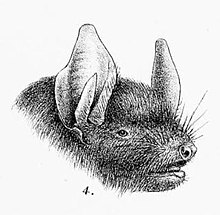| Burmese whiskered myotis | |
|---|---|

| |
| Conservation status | |
 Data Deficient (IUCN 3.1) | |
| Scientific classification | |
| Domain: | Eukaryota |
| Kingdom: | Animalia |
| Phylum: | Chordata |
| Class: | Mammalia |
| Order: | Chiroptera |
| Family: | Vespertilionidae |
| Genus: | Myotis |
| Species: | M. montivagus |
| Binomial name | |
| Myotis montivagus (Dobson, 1874) | |

| |
| Burmese whiskered myotis range in red (eastern Chinese range likely erroneous) | |
The Burmese whiskered myotis or Burmese whiskered bat (Myotis montivagus) is a species of vesper bat. It is found in China, India, Myanmar, Laos, and Vietnam.
Taxonomy
It was previously thought to have a wider range across Asia, ranging west into peninsular India and as far east as Borneo. However, a 2013 study found significant cranial and dental differences between different populations of the species, and thus split it into several distinct species: the Burmese whiskered myotis (M. montivagus sensu stricto), Peyton's myotis (M. peytoni, endemic to India), the Malaysian whiskered myotis (M. federatus, endemic to Peninsular Malaysia), and the Bornean whiskered myotis (M. borneoensis, endemic to Borneo). This has also been followed by the American Society of Mammalogists, the IUCN Red List, and the ITIS.
Distribution and habitat
It ranges from northeastern India north to southern China and south to northern Myanmar. An isolated population (not considered part of M. montivagus by the American Society of Mammalogists) is known from Laos and Vietnam. It is thought to inhabit tropical montane forest for most of its range, although in Vietnam it is also known from lowland habitats, including agricultural fields.
Status
Very little information is known about this species, and it is thus classified as Data Deficient on the IUCN Red List. It may be threatened by the loss or degradation of cave and forest habitats.
References
- ^ Görföl, T.; Tu, V.; Csorba, G.; Francis, C.M.; Hutson, A.M.; Bates, P.J.J.; Bumrungsri, S.; Molur, S.; Srinivasulu, C. (2020). "Myotis montivagus". IUCN Red List of Threatened Species. 2020: e.T85567622A22065126. doi:10.2305/IUCN.UK.2020-2.RLTS.T85567622A22065126.en. Retrieved 17 November 2021.
- ^ "Explore the Database". www.mammaldiversity.org. Retrieved 2022-01-27.
- Görföl, Tamás; Estók, Péter; Gábor, Csorba (2013-03-28). "The Subspecies Of Myotis Montivagus - Taxonomic Revision And Species Limits (Mammalia: Chiroptera: Vespertilionidae)". Acta Zoologica Academiae Scientiarum Hungaricae. 59 (1): 41–59. doi:10.5281/zenodo.5736085.
- "ITIS - Report: Myotis montivagus". www.itis.gov. Retrieved 2022-01-27.
| Taxon identifiers | |
|---|---|
| Myotis montivagus | |
| Vespertilio montivagus | |
This Vespertilionidae article is a stub. You can help Misplaced Pages by expanding it. |